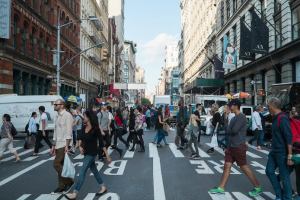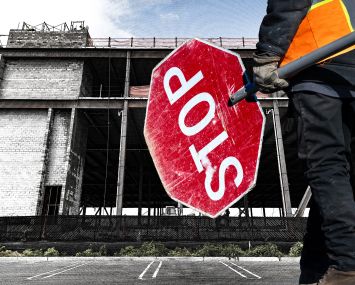Lower Manhattan’s Development Lifts Soho Retail
By Danielle Schlanger October 23, 2014 1:23 pm
reprints

While Soho’s transformation from gritty bohemian enclave to international shopping center is all but complete, the continued development of Lower Manhattan ensures that the area will continue to attract top retailers for top-dollar rents.
“The development that is now occurring in the Financial District creates a connection with Soho because the proximity is fairly close,” said Andrew Mandell, the managing partner at Ripco Real Estate and the chairman of the Real Estate Board of New York’s stores committee. “You’ll see over the years that there will be an overlap of shoppers that visit the Financial District and the [9/11] Memorial pools. Because it’s so close to Soho, there will be an overlap and we may see an increase in shoppers.”
Richard Hodos, an executive vice president with CBRE’s New York Tri-State Region Retail Services team, agreed with this assessment.
“There are now over 60,000 residents that live downtown below Soho and Tribeca, more than triple what was there a dozen years ago,” Mr. Hodos said. “Sixty thousand residents is roughly the size of Greenwich, Conn., a really large town by most standards. All of the incremental residents should translate into incremental sales.”
Mr. Hodos added that “the addition of the commercial office space [Downtown], once it is filled with tenants, will be the icing on the cake” for Soho retailers.
Yet there’s been backlash from the community to the retail-ization of Soho. Many longtime residents are pushing back to ensure the area retains its mixed-use character and hope to prevent the neighborhood from becoming an outdoor mall.
Take the development of 19 East Houston Street, a proposed six-story commercial building at the gateway to the neighborhood, as a case in point.
The uniquely shaped, 6,174-square-foot lot was previously owned by the city and used by the Metropolitan Transportation Authority for parking. In July 2013, the MTA announced its intention to relinquish control of the lot in exchange for $25.825 million for its capital program and a relocation property in the Flatiron District.
After the MTA and the NYC Economic Development Corporation issued a request for proposals, Madison Capital, a New York-based real estate investment and operating company, won the right to buy and develop the site.
Almost immediately, neighborhood residents expressed concerns about Madison Capital’s plans for the site. While concerns ranged from the building jeopardizing the character of Soho’s Historic Cast-Iron District to the impact of a proposed LED billboard, possibly nothing prompted more outrage than the prospect of another mammoth flagship store in the neighborhood’s midst.
“What we have seen in Soho over the past few years is large corporate flagship stores that are overwhelming the district, both in signage and street presence,” said Community Board Chair David Gruber. “So we wanted to make sure that 19 East Houston fit into the fabric of Soho rather than making a corporate statement.”
In May 2014, Community Board 2 denied Madison Capital’s proposal for the lot, which the investment firm calls 606 Broadway. In the community board’s meeting minutes, it is noted, “The residential character of the neighborhood is drowning, and historic character is at risk of becoming the mere quaint visual backdrop of an urban retail mall.”
After a series of negotiations, Madison Capital agreed to concede its third floor of retail space, bringing the total retail space above grade to less than 10,000 square feet. The company also will construct and fund a three-foot extension of the sidewalk along East Houston Street to better accommodate the flow of pedestrians. It has also abandoned its plans for LED signage.
Jonathan Ratner, a director of asset management at Madison Capital responsible for investment management activities, declined repeated requests for comment.
“This problem with retail merchandise loading is one of the main reasons that we were successful in limiting the size of new retail proposed for the development at 19 East Houston Street,” said Pete Davies, an active participant in the Broadway Residents Coalition and a Soho resident for 35 years. “The year-long discussion around this project was not in opposition to retail, but rather a thorough and thoughtful examination of what makes a mixed-use neighborhood work well. It’s a template for future growth in the neighborhood.”
Manhattan Borough President Gale Brewer stressed that the neighborhood should aim to attract and retain smaller stores and eschew large-scale floor plans.
“The kind of thing we need more of is what happened at 130 Prince Street—where the owner agreed to maintain five smaller stores rather than warehouse them into one larger store,” Ms. Brewer said. “In Soho, smaller retail like that helps maintain the character of the neighborhood. And the owner wasn’t afraid to go through [the Uniform Land Use Review Procedure].”
Ms. Brewer also highlighted that the city’s Department of Buildings should carefully consider the future of 529 Broadway, which is currently being marketed as a 50,000-square-foot retail space. Aurora Capital’s Bobby Cayre, Wharton Properties’ Jeff Sutton and Thor Equities’ Joseph Sitt bought the 1936 warehouse in 2012 for $147.9 million. Their plans call for a flagship space designed by BKSK Architects to be occupied in 2016.
“What DOB needs to recognize is that this is one large store, not several smaller ones, and they need to say that this requires a large retail special permit—which means ULURP,” Ms. Brewer said. “The community board and residents must be allowed to weigh in on a 50,000-square-foot flagship, rather than be circumvented.”
She added: “When it’s all large retail, it’s boring. It’s harsh on the eyes. It has no intrinsic value for New York City.”
The community battle against big-box stores has gained traction in recent years. Initially, Soho residents feared luxury developments cropping up in the neighborhood, pushing out the artists residing in joint living/work quarters. With this ongoing gentrification, “less attention was paid to what was happening with retail,” said Tobi Bergman, the chair of Community Board 2’s land use committee.
Since the late 1990s when traditional uptown luxury retailers began moving south, the number and size of stores in Soho grew despite the fact the neighborhood was hard hit following 9/11, given its proximity to Ground Zero and the curtailed tourism that followed the attacks. In turn, pedestrian and truck traffic started becoming an out-of-control problem, undermining the neighborhood’s mixed-use character. In recent years, the problem has become more acute.
“When Bloomingdales first opened [in Soho in 2004], there wasn’t much objection. People kind of liked the idea,” noted Mr. Bergman. “But now, if one bigger store comes in, another bigger store will also come in, and you reach the tipping point where you make the neighborhood no longer work for the people who live there.”
The building at 19 East Houston Street is not the only new development being erected in the area; across the street, a BP gas station at 300 Lafayette Street is being converted by owner Marcello Porcelli into a seven-story commercial building, having received City Council approval in February 2014.
Retailers’ demand for space has impacted rents in Soho.
According to CBRE’s retail report from the second quarter, Greene Street’s rents have more than doubled in the last year, to $500 per square foot from $200 per square foot. Current average asking rents on Spring and Prince Streets range from $675 to $1,250. And in some parts of Soho, asking rents have exceeded $1,500 per square foot. The report also indicates that rents on Broadway from Houston to Broome Streets increased 7.56 percent in the past year.
“Now the retail is getting out of hand and is dominating everything,” Mr. Bergman said. “If you convert Soho into a shopping mall, it ceases to have that specialness.”
Mr. Mandell said that the area’s ambiance is particularly appealing to tourists.
“Last year, our city had 54 million visitors,” he said. “And Soho’s architecture, charm and the character and quality of tenants have made it a place where people from all over the country and all over the world want to visit and shop. It’s [also] very accessible by mass transportation, which in any retail area is critical for success.”
Today, international retailers including Gap, Zara and Topshop line the area along Broadway. Luxury retailers including Prada, Derek Lam and Alexander Wang have flagship stores in the neighborhood.
Moreover, the luxury stores, from Louis Vuitton and Tiffany & Co. on Greene Street to Celine on Wooster Street to Versace on Mercer Street, largely do not cater to local clientele.
“There is definitely a luxury [geographic] ‘Z’ forming from Chanel and Burberry on Spring Street up Greene Street between Spring and Prince then on Prince to Mercer and on Mercer to Houston—all of the luxury players want to be within that ‘Z,’ ” said Mr. Hodos.
While multinational chain stores are largely drawn to Broadway, Mr. Hodos noted that many of the newer retail arrivals target their offerings to the neighborhood.
“[For example], Carson Street Clothiers [at 63 Crosby Street] does a great job of curating their clothes for a millennial man,” Mr. Hodos said. “When the Internet retailers want a brick-and-mortar store, they are usually starting in Soho, like Piperlime and Warby Parker have.”
While many longtime Soho establishments have left the neighborhood, Mr. Hodos suggested that new arrivals still reflect the area’s character.
“Organic growth over the years has pushed out the art galleries and some wonderful, local concepts,” Mr. Hodos said. “However, for the most part, what has replaced what was lost is commercially successful, interesting and colorful, in a very ‘Downtown’ way.”
Faith Hope Consolo, the chairman of Prudential Douglas Elliman’s Retail Leasing and Sales Division, also believes the neighborhood has not yet maximized its potential.
“[Soho] will continue to boom. We’ll see more retailers opening on side streets because the main thoroughfares such as Prince [Street] are fully leased,” Ms. Consolo said. “West Broadway will continue to lease up, and create essentially a corridor that will run from the neighborhood straight down to FiDi.”
Not everything about Soho’s sweeping gentrification has adversely impacted residents. Mr. Mandell noted, “The changes over the years [in Soho] and increased values have benefitted owners that were fortunate enough to have acquired their properties decades ago.”
He added, “I do however understand why a lifelong resident may be overwhelmed by the number of people the area draws.”
New York City Council Member Margaret Chin, who represents Soho, had strong words for developers to heed when planning to enter the neighborhood.
“If [developers are coming into Soho], don’t come in with designs or proposals that will get community opposition,” she said. “Don’t come in with a big-box store that has multi-story retail.”


